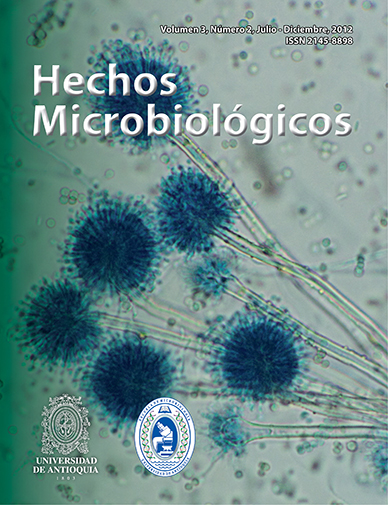Physicochemical parameters associated with the proliferation of filamentous bacteria (filamentous bulking) in wastewater treatment plants using activated sludge: a systematic review
DOI:
https://doi.org/10.17533/udea.hm.18736Keywords:
activated sludge, bulking, filamentous bacteria, filamentous index, sludge volume indexAbstract
Downloads
References
Bitton G. Microbiology of wastewater treatment. En: Bitton G. Wastewater microbiology. 3a ed. New Jersey: John Wiley & Sons, INC; 2005. p. 211-395.
Agridiotis V, Forster CF, Balavoine C, Wolter C, Carliell-marquet C. An examination of the surface characteristics of activated sludge in relation to bulking during the treatment of paper mill wastewater. Water Environ J. 2006; 20(3): 141-149.
Donkin mJ. Bulking in aerobic biological systems treating dairy processing wastewaters. Int J Dairy Technol. 1997; 50(2): 67-72.
Guo J, yongzhen P, Wang s, yang X, Wang Z, Zhu A. Stable limited filamentous bulking through keeping the competition between floc-formers and filaments in balance. Bioresour Technol. 2012; 103 (1): 7-15.
Mesquita DP, Amaral Al, Ferreira eC. Identifying different types of bulking in an activated sludge system through quantitative image analysis. Chesmofe-re. 2011; 85(4): 643-652.
Pernelle JJ, Gaval G, Cotteux e, Ducheá P. Influence of transient substrate overloads on the proliferation of filamentous bacterial populations in an activated sludge pilot plant. Wat. Res. 2001; 35(1): 129-134.
Pacheco V, Jáuregui B, Pavón T, mejía G. Control del crecimiento de microorganismos filamentosos en una planta de tratamiento de aguas residuales industriales. Rev. Int. Contam. Ambient. 2003; 19(1): 47-53.
Hashemi sH, Azimi AA, Torabian A, nabi G, Mahmoodkhani R. Low dissolved oxygen sludge bulking in sequencing batch reactors. Int J Environ Stud. 2005; 62(4): 415-420.
Eikelboom DH, Van Buijsen HJJ. Microscopic Slud-ge Investigation Manual. 2a ed. Netherlands: TNO; 1981.
Eikelboom Dick H. Process control of activated sludge plants by microscopic investigation. 1a ed. UK: IWA publishing; 2000.
Mielczarek AT, Kragelund C, eriksen Ps, nielsen PH. Population dynamics of filamentous bacteria in Danish wastewater treatment plants with nutrient removal. Water Res. 2012; 46(12): 3781-3795.
Kragelund C, levantesi C, Borger A. Identity, abundance and ecophysiology of filamentous bacteria belonging to the Bacteroidetes present in activated sludge plants. Microbiology. 2008; 154(3): 886-894.
Martins AmP. Bulking sludge control: kinetics, substrate storage, and process design aspects. Wat Res. 2004; 38(4): 793-817.
Richard m, sear-Brown, Collins F. Activated sludge microbiology problems and their control [Monografía en línea]. Nueva York: Presented at the 20th annual Usepa national operator trainers conference; 2003 [Acceso 20 de Marzo de 2013] Disponible en: http://www.dec.ny.gov/docs/water_pdf/drrichard1.pdf
Liao J, lou I, de los Reyes III Fl. Relationship of Species-Specific Filament Levels to Filamentous Bulking in Activated Sludge. Appl Environ Microbiol. 2004; 70 (4): 2420-2428.
Gulez G, de los Reyes III Fl. Multiple approaches to assess filamentous bacterial growth in activated sludge under different carbon source Conditions. J Appl Microbiol. 2008; 106(2): 682-691.
Horan n, lavender P, Cowley e. Experience of activated-sludge bulking in the UK. Water Environ J. 2004; 18(3): 177-182.
Graveleau l, Cotteuxa e, Duchène P. Bulking and Foaming in France: The 1999-2001 survey. Acta hydrochim hydrobiol. 2005; 33(3): 223-231.
Baxter-Plant Vs, Hayes e, Forster CF. Problems Caused by Filamentous Bacteria in Pilot-Scale Nutrient-Removal Activated-Sludge Plants. Water Environ J. 1999; 13(2): 131-136.
Tsang yF, Chua H, sin sn, Tam Cy. A novel technology for bulking control in biological wastewater treatment plant for pulp and paper making industry. Biochem Eng J. 2006; 32(3): 127-134.
Madoni P, Davoli D, Gibin G. Survey of filamentous microorganisms from bulking and foaming activated-sludge plants in Italy. Wat Res. 2000; 34(6): 1767-1772.
Gaval G, Pernelle JJ. Impact of the repetition of oxygen deficiencies on the filamentous bacteria proliferation in activated sludge. Wat Res. 2003; 37(9): 1991-2000.
Krhutková O, Denisb nicolas, Wanner Jirí. Screening of Filamentous Microorganisms in Activated Sludge Plants. Acta hydrochim hydrobiol. 2005; 33(3): 270-274.
Flores-Alsina X, Comas J, Rodriguez-Roda I, Gernaey KV, Rosen C. Including the effects of filamentous bulking sludge during the simulation of was-tewater treatment plants using a risk assessment model. Wat Res. 2009; 43(18): 4527-4538.








